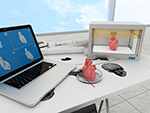
There are some exclusive waiting lists no one would choose to be on and those are the ones for organ transplants. Even though 2015 was a record year for organs transplanted, the gap between need and supply continues to be huge. That's why scientists continue to look to 3D printing as a solution.
Bioprinting uses inkjet-like technology to build layer upon layer of biocompatible material that will provide a scaffolding to which cells adhere. This printed scaffolding provides the shape and structure for the tissue or organ based on location and need. For example, a bioprinted trachea would be printed to the specific dimensions required by the recipient. Eventually the biocompatible structural materials degrade, leaving the tissue intact.
In recent studies, a new bioprinting technology provides spaces in the printed tissue for blood vessels so that once implanted blood vessels will grow and provide nutrients and oxygen to the tissue ensuring its survival. In a recent study, researchers used a biocompatible scaffolding material called hydrogel to print cartilage in the shape of a human ear, muscle and a jawbone.
They used 3D scans of existing tissues to provide instructions for the computer assisted design printing. Implanted into mice, these engineered tissues remained completely viable and began to develop a blood supply.
While these are first steps, we may look back on these as the 'proof of principle' for printing organs for transplantation. Once further developed, this will mean saving lives and creating a limitless supply of life saving organs.